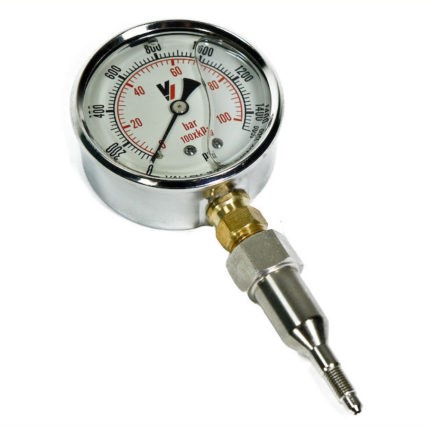Ultimately all brake systems rely on pressure to activate the calipers. There are lots of articles on pedal ratio and master cylinder sizing, all of which are important. However, the pedal ratio and master cylinder arrangement only serve to create the line pressure that the calipers use to clamp the discs, and what is appropriate for a 300 pound monster in the seat may be largely different than the requirements of a 100 pound driver. The great equalizer is line pressure, all drivers, regardless of size will need the same brake line pressure to stop the car effectively.
If everything is held equal (M/C bore, pedal ratio, caliper size), let’s assume that our 300 lb. driver can exert 150 lbs. of pedal pressure while our 100 lb. driver may only be able to exert 95 lbs. The difference between those two in stopping power is: (150-95)/95 x 100 = 58%. The 300 lb. driver can create 58% more stopping power under normal circumstances. This will dramatically affect the cars braking performance, as well as the driver’s confidence and comfort. There are a variety of ways to adjust for this discrepancy, which we will discuss in a separate post; for the purposes of this discussion, we just need to realize that it is there.
When installing or maintaining a racing brake system, line pressure needs to be a known quantity, there are a variety of brake pressure gauges available on the market; the one we sell screws directly into the caliper bleed port and reads directly. Determining brake line pressure should be part of base lining the car during the assembly process. It is also very handy for troubleshooting should brake system issues arise.
How do we check it?
The process is simple: the first thing to do is to remove any proportioning that may be present in the system. If you have an adjustable proportioning valve, it should be adjusted so that the line sees full pressure (generally fully clockwise). If you have a factory proportioning valve, you should remove it and re-plumb with an adjustable one. These are race cars we are talking about, and we will need the adjustability to balance the system at a later date. Next, install the brake pressure gauge in one of the front calipers. Have the actual driver, seated normally in the car with their arms folded across their chest, press on the pedal with their usual braking foot as hard possible for 3 seconds, record the reading. Repeat the process for the rear calipers.
The front and rear numbers should be the same within a couple percentage points. If they are not, there is some proportioning in the system, which should be eliminated, and the system retested.
What is the target?
For TBM brakes, under these circumstances, we recommend a brake line pressure of 950 -1000 psi. This gives us a system that is easy to modulate for normal braking, is comfortable to drive, and still allows some headroom for panic stops, which could cause line pressure to spike upwards of 1400-1500 psi.
What if my results don't match the target?
Numbers outside the normal range should be addressed, and can be, in a variety of ways. If you need to make a change to bring the numbers within recommendations, give us a call or post up your question, we are happy to help!

